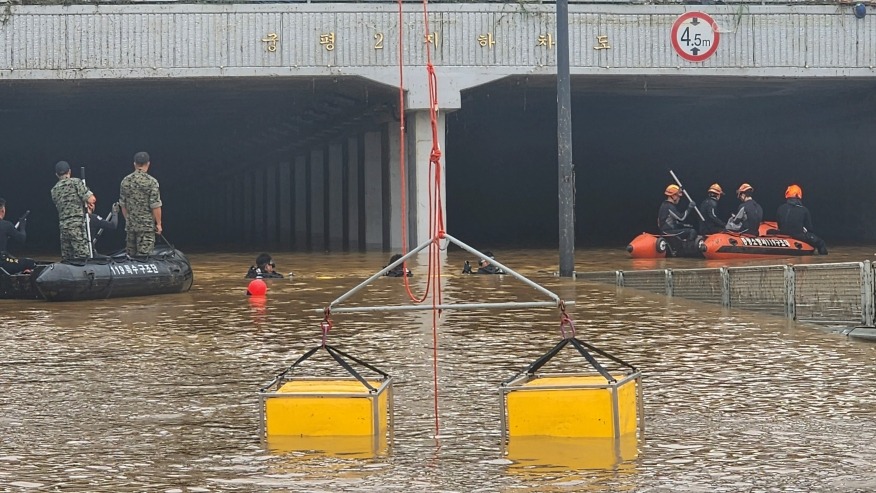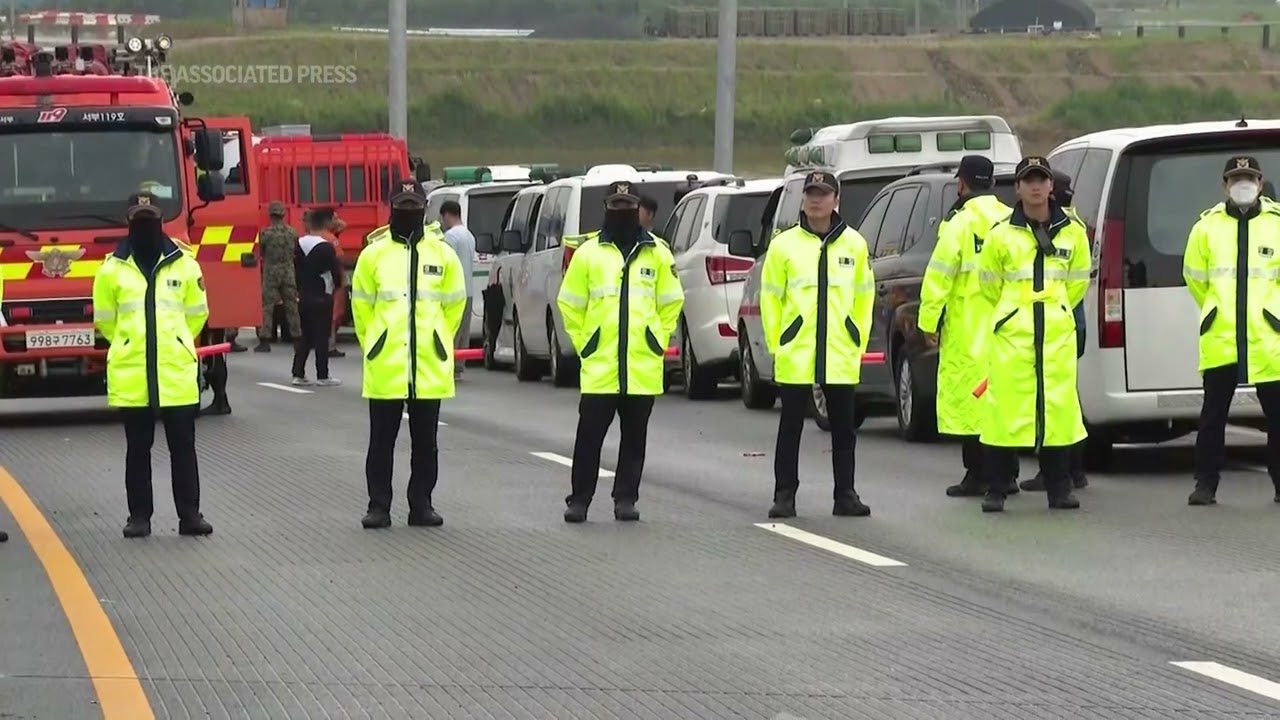Seven Dead In South Korea After Flooding Trap 15 Vehicles In Tunnel
South Korea faced a devastating natural disaster when flash floods struck the traffic tunnel in the central city of Cheongju. Seven dead in South Korea after flooding trap 15 vehicles in tunnel.
Author:Maxwell CanvasReviewer:Scarlet SunsetJul 17, 202314.2K Shares263.6K Views

South Korea faced a devastating natural disaster when flash floods struck the traffic tunnel in the central city of Cheongju. Seven dead in South Korea after flooding trap 15 vehicles in tunnel.
The torrential rains caused widespread flooding and landslides, trapping vehicles inside the tunnel and leading to a challenging rescue operation. Days of severe rain resulted in landslides and flash floods, killing at least 33 people.
This incident highlighted the destructive power of nature and the urgent need for effective disaster management strategies. This article provides a detailed account of the incident in which seven dead in South Korea after flooding trap 15 vehicles in tunnel and its aftermath.
The Flash Floods And The Trapped Vehicles
According to media accounts, rescue personnel in South Korea found seven dead from a bus stranded in a flooded underground tunnel after days of severe rains triggered widespread floods, landslides, and the breach of a large dam.
Officials in the central town of Osong told on Sunday (July 16, 2023) that six additional bodies had been retrieved from the 685-meter-long (2,247-foot) tunnel as rescuers tried to reach many individuals who remained trapped.
Seo Jeong-il, chief of the city's fire department, said in a briefing that over 900 rescuers, including divers, were scouring the tunnel in the central city of Cheongju, where the vehicles, including a bus, were drowned by a flash flood Saturday evening.
Photos and video from the scene showed rescue workers constructing a cordon and pumping brown water out of the tunnel while divers moved in and out using rubber boats.
After three days of torrential rain, the banks of the neighboring Miho River crumbled, flooding the four-lane underpass.
According to media sources, the flood raced into the tunnel too swiftly for people to escape. According to fire officials, the tunnel filled with water in as little as two or three minutes.
Rescue crews recovered one body from the tunnel on Saturday and saved nine individuals who clung to the walls of the guard rails surrounding the tunnel.
On Saturday (July 15, 2023), there were 15 vehicles stranded in the tunnel, including the bus and 12 cars, and 11 persons were reported missing.
One of the nine survivors said:
“„“There were many cars inside the tunnel when the water began coming in and it rose very rapidly. I don’t understand why the tunnel wasn’t closed earlier.- One of the nine survivors
Since July 9, South Korea, which is in the midst of its summer monsoon season, has been pummeled by severe rains.
The Ministry of Interior and Safety announced that 26 persons were killed in landslides and flooding caused by heavy rains. All of the fatalities occurred in the country's center and southeastern regions.
The vast majority of the casualties, including 17 fatalities, came from North Gyeongsang province, where nine people are still missing, owing to massive landslides in the mountainous territory that devoured houses with people inside.
According to one rescue responder, "entire houses were swept away whole" in the most seriously hit locations.
According to the government, the downpour compelled 5,570 individuals to escape. Thousands of people were forced to escape their homes as the Goesan Dam in North Chungcheong province overflowed on Saturday morning, drowning low-lying villages nearby.
Almost 4,200 individuals remained in temporary shelters as of Saturday night.
The downpours have caused travel disruptions across the country, causing the cancellation of 20 flights and the suspension of regular train services and certain bullet trains, according to the ministry.
It went on to say that nearly 200 routes were stopped.
According to his office, President Yoon Suk-yeol, who was in Ukraineon Saturday, instructed Prime Minister Han Duck-soo to mobilize all available resources to respond to the tragedy.
The prime minister advised officials to anticipate river floods and landslides and asked for assistance from the defense ministry for rescue operations.
Meanwhile, the Korea Meteorological Administration issued heavy rain warnings, stating that further rain was expected until Wednesday next week and that the meteorological conditions constituted a "grave" risk.
South Korea is frequently flooded during the summer monsoon season, but the country is normally well-prepared, and the death toll is usually low.
Last year, it saw unprecedented rainfall and flooding, which killed at least 11 people. They comprised three people confined in a Seoul semi-basement apartment of the type made famous by the Oscar-winning Korean film Parasite.
The South Korean government stated at the time that the flooding in 2022 was the highest rainfall since Seoul's weather records began 115 years ago, and blamed the harsh weather on climate change.
Rescue Operations And Recovery Efforts
Rescue operations commenced immediately, with emergency responders and volunteers working tirelessly to save those trapped inside the tunnel. Divers were deployed to navigate the dangerous floodwaters and search for survivors. However, the challenging conditions, including low visibility and fast currents, hindered their efforts. Despite the valiant attempts of the rescue teams, the toll of the disaster became evident as the bodies of seven victims were recovered from the flooded tunnel.
The Tragic Loss And Mourning
The newsof the deaths deeply saddened the nation, as families and communities mourned the loss of their loved ones. Each life lost in the incident represented an irreplaceable void in the lives of their families, friends, and the wider society. As the victims' identities were revealed, condolences and sympathies poured in from across the country and the international community.
Investigating The Causes
Authorities swiftly initiated investigations to determine the causes of the incident and identify any lapses in infrastructure or emergency response protocols. Preliminary assessments suggest that the heavy rainfall overwhelmed the drainage system, leading to flash floods. The investigation aims to evaluate the structural integrity of the tunnel, assess the effectiveness of existing safety measures, and recommend improvements to prevent similar tragedies in the future.
The Importance Of Disaster Preparedness
This incident serves as a reminder of the critical need for effective disaster preparedness and response mechanisms. South Korea experiences heavy monsoon rains annually, making it essential to ensure that infrastructure can withstand such events and that emergency services are adequately equipped to handle potential emergencies. The authorities are likely to review and strengthen their disaster management strategies to prevent or mitigate the impact of future calamities.
Support And Assistance For The Affected
In the aftermath of the incident, the South Korean government, along with local organizations and communities, extended support and assistance to the affected families.
Efforts were made to provide counseling services and financial aid to help them cope with their loss and rebuild their lives. The incident also prompted discussions on the importance of providing comprehensive support systems for victims of natural disasters.
How To Improve Disaster Management Strategies In South Korea?
Disaster management is a critical aspect of ensuring the safety and well-being of communities in the face of natural calamities. South Korea, a country prone to various natural hazards such as floods, typhoons, and earthquakes, recognizes the importance of continuously improving its disaster management strategies.
By learning from past incidents and implementing effective measures, South Korea can enhance its preparedness, response, and recovery capabilities. This section explores several key areas where disaster management strategies in South Korea can be improved to better protect its population.
Strengthening Early Warning Systems
An effective early warning system is crucial for minimizing the impact of disasters. South Korea should focus on enhancing its infrastructure and technologies to provide timely and accurate warnings to vulnerable communities.
This includes investing in advanced meteorological monitoring systems, improving data collection and analysis, and ensuring efficient dissemination of warnings through multiple channels such as mobile alerts, sirens, and public broadcasting systems.
Public education and awareness campaigns should also be conducted to ensure that individuals understand the importance of heeding early warnings and taking appropriate actions.
Enhancing Emergency Response Coordination
Coordination among different agencies and stakeholders is vital during disaster situations. South Korea should strive to improve interagency collaboration and communication to ensure a seamless response.
This involves establishing clear lines of communication, defining roles and responsibilities, and conducting regular joint exercises and simulations.
Strengthening coordination between local, regional, and national authorities will enable a more efficient mobilization of resources, including personnel, equipment, and relief supplies. Encouraging the involvement of community organizations, volunteers, and the private sector can further enhance the overall emergency response capabilities.

Bodies pulled from flooded tunnel in South Korea
Investing In Resilient Infrastructure
Building resilient infrastructure is key to minimizing the impact of disasters and ensuring quick recovery. South Korea should prioritize investments in infrastructure projects that consider potential hazards and incorporate appropriate mitigation measures.
This includes constructing flood-resistant buildings, reinforcing critical lifeline infrastructure such as bridges and power grids, and improving drainage systems to cope with heavy rainfall. Implementing stricter building codes and standards, as well as conducting regular inspections and maintenance of existing infrastructure, can help safeguard communities during disasters.
Enhancing Disaster Risk Reduction And Preparedness
Investing in disaster risk reduction and preparedness is essential for South Korea's long-term resilience. This involves conducting comprehensive risk assessments to identify vulnerable areas and populations and implementing measures to reduce their exposure to hazards.
Developing community-based disaster management plans, conducting drills and exercises, and providing training in first aid and emergency response can empower individuals and communities to take immediate action during crises. Additionally, integrating disaster risk reduction into school curricula can foster a culture of preparedness among the younger generation.
Strengthening Post-Disaster Recovery And Rehabilitation
Efficient and timely post-disaster recovery is crucial for restoring normalcy in affected areas. South Korea should focus on streamlining the processes for assessing damages, providing financial assistance, and coordinating reconstruction efforts.
Establishing dedicated recovery funds and mechanisms can expedite the allocation of resources for rebuilding infrastructure, housing, and livelihoods. Emphasizing community participation and ensuring transparent decision-making processes can foster a sense of ownership and resilience among affected communities.
South Korea's commitment to improving disaster management strategies is crucial in safeguarding its population and minimizing the impact of natural disasters.
By strengthening early warning systems, enhancing emergency response coordination, investing in resilient infrastructure, promoting disaster risk reduction and preparedness, and streamlining post-disaster recovery efforts, South Korea can significantly enhance its disaster resilience. These proactive measures, combined with continuous learning and adaptation, will contribute to a safer and more resilient future for all South Koreans.
People Also Ask
How Many People Were Killed In The Flooding Incident In South Korea's Traffic Tunnel In The Central City Of Cheongju?
Seven people lost their lives in the flash floods that trapped 15 vehicles inside the central city of Cheongju Traffic Tunnel.
What Caused The Flash Floods In South Korea's Central City Of Cheongju?
The flash floods in the central city of Cheongju of South Korea were triggered by heavy rainfall that overwhelmed the drainage system.
How Did The Authorities Respond To The Flooding Incident In The Tunnel?
Emergency responders and volunteers immediately initiated rescue operations, deploying divers to search for survivors in the flooded tunnel.
What Measures Are Being Taken To Prevent Similar Incidents In The Future?
Authorities have launched investigations to assess the causes of the incident and identify any infrastructure or emergency response shortcomings. The findings will guide improvements to prevent or mitigate the impact of similar tragedies in the future.
Conclusion
Seven dead in South Korea after flooding traps 15 vehicles in tunnel. The flash floods that struck the central city of CheongjuTraffic Tunnel in South Korea resulted in the tragic deaths of seven individuals.
This devastating incident highlighted the need for robust disaster management strategies and effective infrastructure to mitigate the impact of natural disasters. As investigations continue to determine the causes and lessons learned from this incident, it is crucial to prioritize the safety and well-being of individuals and communities, ensuring their resilience in the face of future calamities.
Jump to

Maxwell Canvas
Author
Maxwell Canvas, a charismatic and fearless crypto evangelist, defies conventions and blazes a trail in the realm of digital currencies. With his unique physique serving as a symbol of resilience, he challenges societal norms and proves that true expertise transcends appearances. Against a backdrop of a blurred and ever-shifting market, Maxwell's work becomes a masterpiece, painting a vivid picture of knowledge and inspiration.
With unwavering passion, Maxwell empowers others to embrace the transformative potential of blockchain technology. His captivating presence and unyielding dedication captivate audiences, turning skepticism into curiosity and igniting a spark of interest in the world of cryptocurrencies. Maxwell Canvas stands as a visionary force, leaving an indelible mark on the crypto landscape, inspiring others to explore decentralized possibilities and embrace a future of innovation and financial empowerment.

Scarlet Sunset
Reviewer
Scarlet Sunset is a captivating and confident transgender individual who radiates sensuality and embraces her unique beauty. With a radiant smile and a touch of red lipstick, she captivates hearts by the poolside as the sun dips below the horizon, casting a warm glow on her unforgettable presence.
Despite societal norms and expectations, Scarlet celebrates her body, proudly defying conventional standards of beauty. Her curves tell a story of self-acceptance and empowerment, challenging stereotypes and inspiring others to embrace their own bodies without reservation.
Latest Articles
Popular Articles
